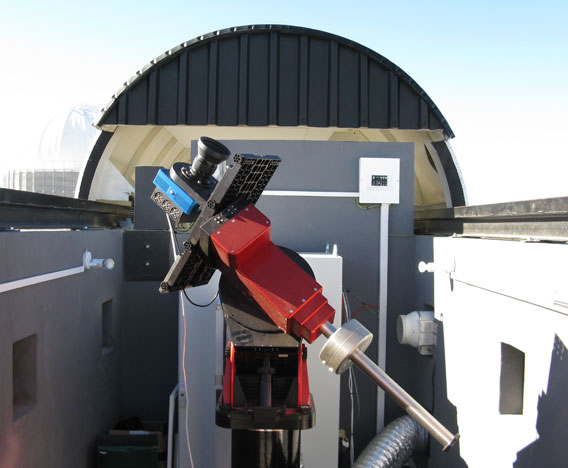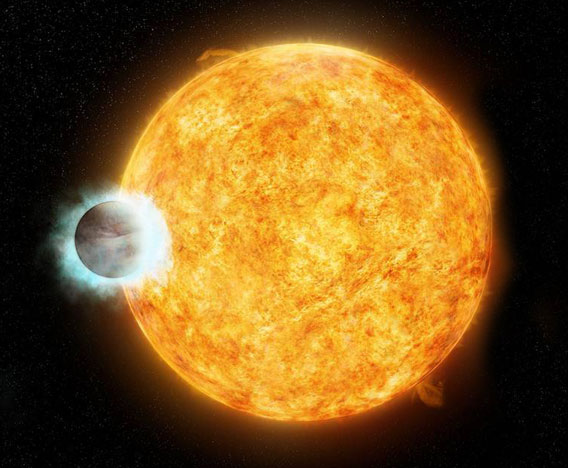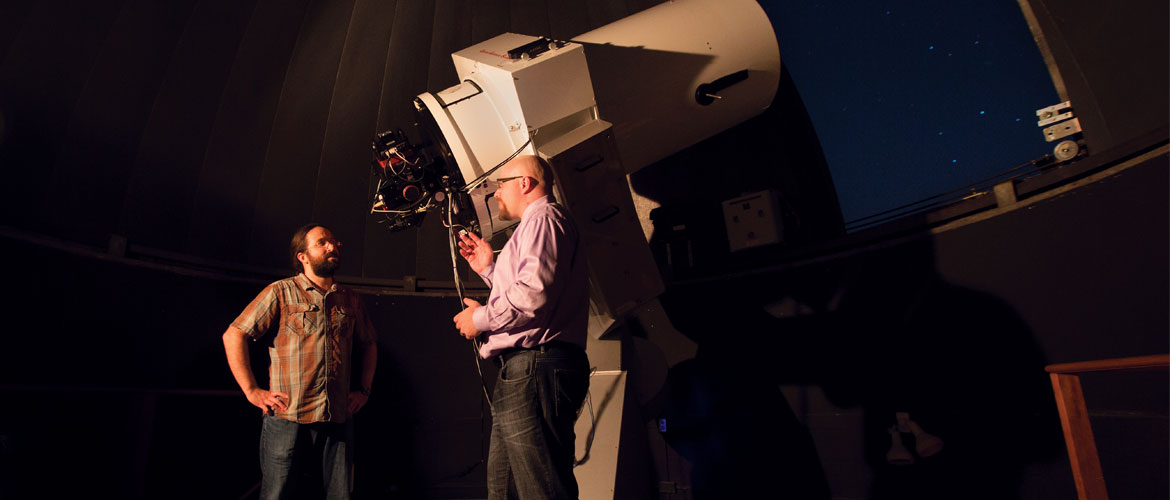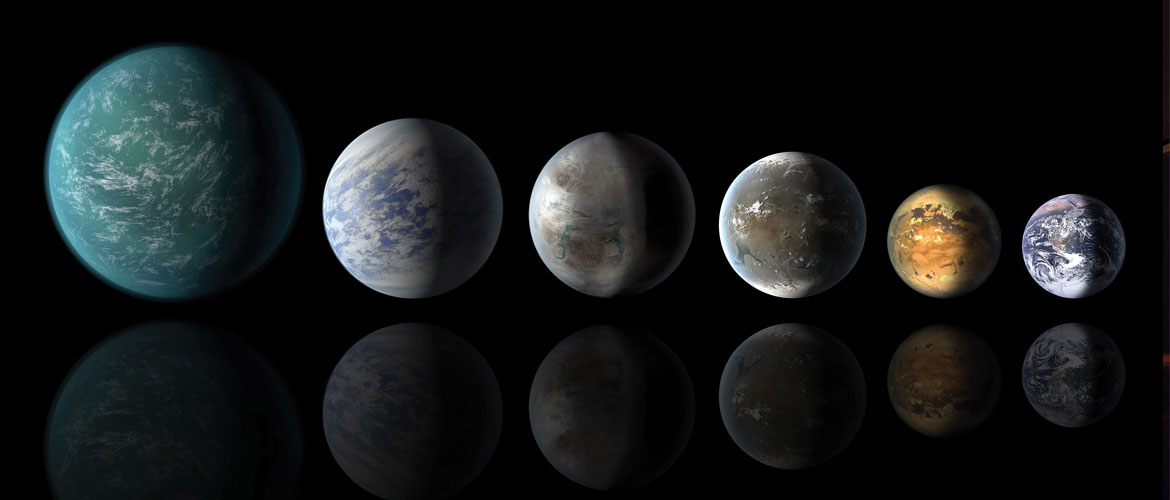With modest telescopes, Josh Pepper and his KELT team are helping NASA find planets beyond the solar system that could hold life—or already do.
Back in 2002, in his first year as a graduate student at Ohio State University, Joshua Pepper was sitting in his office one day when a professor walked by and asked what he was doing.
Nothing much, Pepper said.
Good, the professor replied. Then you’ll have time to work on my project.
Pepper, an astronomy student, was studying the giant black hole in the center of the Milky Way Galaxy. The professor wanted to determine if an upcoming NASA mission could locate exoplanets—planets orbiting other stars. The professor was not his adviser, but Pepper saw no way to decline. What was supposed to be a three-month project became a one-year investigation. During that time, the planned NASA mission was scrapped, but Pepper made a more significant discovery: The search for planets beyond the solar system—and potentially for life as well—could be effectively conducted with modest equipment.
“We did a set of theoretical exercises looking for the best way of searching for exoplanets,” he says. “We showed that we could design a small telescope and use it to find exoplanets in a more efficient and cost-effective way.”

Pepper’s low-budget KELT telescopes, like this one in Arizona, search for exoplanets by scanning large swaths of the sky and recording changes in the brightness of stars located not too distant from the solar system.
Pepper put his theories into action. On a budget of under $50,000, he built the Kilodegree Extremely Little Telescope, or KELT, and deployed it at a private observatory near Sonoita, Arizona, an hour southeast of Tucson. KELT-North, as it is called, stands 6 feet high and weighs about 75 pounds.
Five years later, as a postdoctoral fellow at Vanderbilt University, Pepper built a second telescope, KELT-South, and stationed it in South Africa to observe the southern sky.
Today, Pepper is an assistant professor of physics at Lehigh. (His father, Stephen Pepper ’59, earned a B.S. in engineering physics and spent more than 50 years working at NASA in Cleveland, Ohio.) He runs the KELT project with researchers at Ohio State and Vanderbilt.
The KELT scientists collaborate with amateur astronomers and with researchers at other universities and large observatories. The KELT Follow-Up Network, with 40 members in 10 countries, is the largest of its kind in the world. It has confirmed the discovery of 13 exoplanets and is preparing to announce the discovery of four more.
Earlier this year, the KELT group reported the discovery of KELT-11b, a low-mass gas giant exoplanet orbiting a bright star in the southern sky. The group also helped NASA confirm the existence of Kepler 1647-b, a rare circumbinary exoplanet orbiting two stars, that was discovered by researchers at the Goddard Space Flight Center and San Diego State University using the Kepler Space Telescope.
“We’ve been incredibly successful,” says Pepper, “and very, very lucky.”
KELT is designed to study bright stars located relatively close to the solar system and to record changes in their brightness. For this, it is more important to observe a large number of stars at one time than to observe one star in great detail. Thus, KELT’s 2-inch telephoto lens observes a 26-degree swath of the sky at one time and can cover the entire sky in nine different pointings.
By contrast, powerful telescopes are designed to find distant objects and examine them in great detail while observing a much smaller portion of the sky. Thus, the Hubble Telescope, one of the world’s largest, would require 20 million pointings to cover the entire sky.
“A tradeoff is involved,” says Pepper. “If your telescope has a larger aperture and a narrower field of view, you will see a lot more stars but many of them will be faint. We designed our telescope to match the stars we wanted to probe.”
A decrease in a star’s brightness, says Pepper, can indicate that it is orbited by one or more planets. The change is minuscule. An exoplanet the size of Jupiter that is transiting its host star—passing between it and the Earth—diminishes the star’s brightness by an average of only 1 percent.
Watching the night sky for a slight dip in a star’s brightness requires time and patience, says Pepper.
“To find an exoplanet, you have to stare for a long time at a large number of stars until eventually you see a star experiencing a transiting event with dimming caused by the planet crossing in front of the star and blocking its light.”
“To find an exoplanet, you have to stare for a long time at a large number of stars until eventually you see a star experiencing a transiting event with dimming caused by the planet crossing in front of the star and blocking its light.
“We measure the brightness of 100,000 stars at once, and take that measurement again and again. That’s all our telescope does night after night. It measures the brightness of all the stars over and over again and builds a record. After we collect years of data, we examine the data to see if any dimming has occurred in any of the stars.
“In the past decade or so, we have monitored 5 million stars in this way.”
To increase the odds of finding an exoplanet, the KELT team searches for what Pepper calls “hot Jupiters,” large planets that orbit close to their host star and dim its light at regular and frequent intervals. All the planets the team has found are gas giants 300 to 1,000 light-years from Earth with outer layers hotter than 1,000 degrees Celsius. All orbit their suns in less than 10 days. (By comparison, Mercury, the planet closest to the sun, has an 88-day revolution.) And all the KELT exoplanets are more than 10 times closer to their suns than is Mercury, which lies 33 million miles distant from the sun.
“Only a small fraction of exoplanets are big enough for us to detect,” says Pepper. “Of those, only a small fraction transit in front of their host star and allow us to detect its dimming.”

An artist’s illustration using data from NASA’s Chandra X-ray Observatory depicts a star named WASP-18 and its exoplanet, a “hot Jupiter” named WASP-18b. Hot Jupiters orbit close to their host star and dim its light at frequent intervals. WASP-18b, whose mass is about 10 times that of Jupiter’s, orbits WASP-18 once every 23 hours. (Image credit: X-ray: NASA/CXC/SAO/I.Pillitteri et al; Optical: DSS)
The transit method, or dip as it is also called, is one of two techniques that Pepper’s team uses to detect an exoplanet. The other, called the radial velocity technique, aka the wobble, seeks to detect the slight tug that an exoplanet exercises on the star it is orbiting. Both techniques yield information about a planet’s orbit. The wobble also allows researchers to measure a planet’s mass, while the transit enables them to measure its radius and calculate its volume. By dividing mass by volume, the researchers can determine a planet’s density—and its composition.
“Because different materials—water, rocks, metal, gases—have different densities,” says Pepper, “we can figure out a planet’s composition once we know its mass and radius.”
By searching for hot Jupiters, Pepper and his team hope to help scientists search for planets that could be habitable or are inhabited. That endeavor, he says, is extraordinarily difficult.
“A planet supporting life as we know it would have to be like the Earth. It would not be orbiting close to its sun and would be much harder for us to detect it and measure its mass, size, orbit and density. The wobble and transit signals from a hot Jupiter, which is much larger and closer to its host star than an Earth-like planet, are much stronger than they would be for an Earth-like planet.”
An exoplanet’s ability to support life hinges on the composition of its atmosphere. By learning to probe the relatively easy-to-study atmosphere of hot Jupiters discovered by the KELT team, scientists hope to improve their techniques in anticipation of the discovery of Earth-like exoplanets.
“Studying hot Jupiters helps us develop the technique that we will use in 20 or 30 years to measure the atmosphere of an Earth-like exoplanet,” says Pepper.
To analyze the atmosphere of an exoplanet, scientists take a spectrum of the light beaming unimpeded from the planet’s host star. Then they take a spectrum of the much smaller quantity of light coming from the star that is filtered through the atmosphere of a transiting planet. Comparing the two spectra yields clues about the elemental composition of the atmosphere, says Pepper, because elements have different spectral signatures.
“The light from the star changes color when it interacts with the molecules of the planetary atmosphere,” he says. “So we see one spectrum for the light that is coming unfiltered from the star and a different spectrum for the light coming through the planetary atmosphere.”
Measuring the differences between those two spectra, says Pepper, is a formidable task.
“In the best possible scenario, for a hot Jupiter, 99 percent of the light we see comes directly from the star, unfiltered. One percent of the light is blocked by the transiting exoplanet. Only 0.01 percent of the light we see represents the atmosphere’s spectral signature, that is, it has been filtered by the planet’s atmosphere.
“In this scenario, we’re trying to disentangle one photon out of every 10,000 that we see and measure a spectrum of light just from that subset of photons.”
To take the same measurement for a potentially habitable planet that is much smaller than a hot Jupiter and much further from its host star, the numbers become far more daunting.
“In that case, 99.9 percent of the light we see is coming directly from the star, unfiltered,” says Pepper. “About 0.1 percent of the light is being blocked by the transiting exoplanet, and 0.001 percent of the light represents the atmosphere’s spectral signature.”

Pepper, right, with Kutztown University astronomer Phillip Reed '08, Ph.D. A CCD camera inside Kutztown's 24-inch telescope takes digital images of exoplanetary transits, in which a planet passes in front of its host star, affecting the star's brightness and yielding possible clues about the elemental composition of its atmosphere. If the astronomers and their students are lucky, their nighttime shift will span all five stages of a transit.
Scientists have not yet developed spectroscopy technology that can disentangle the photons from the unfiltered and filtered light streams in this scenario, says Pepper.
In the meantime, the KELT team is continuing the quest for hot Jupiters on which scientists can hone their techniques for analyzing exoplanetary atmospheres.
“The goal of KELT is to discover planets that are good test beds for the techniques that will eventually be used to probe habitable planets,” says Pepper.
“We’re finding a lot of cool things. Scientists have measured properties for 10 exoplanets and have found carbon dioxide, sodium, water and hydrogen, all of which we expect to find in the atmospheres of giant planets.
On most clear nights, Phillip Reed and his students head to the Kutztown University Observatory to search for exoplanets. Reed, who joined the KELT Follow-Up Network in 2013, earned a Ph.D. in physics from Lehigh in 2008 and is now associate professor of physics and astronomy at Kutztown.
Arriving at the observatory, Reed and his students check KELT’s online transit finder. The secure website lists five or six candidate stars with information about each star’s brightness and the expected magnitude of a possible exoplanet transit.
The 24-inch Kutztown telescope is valued by the KELT researchers, says Reed, because it contains a sophisticated photometer that can detect an exoplanet while it transits its host star and blocks its light.
“KELT comes up with candidate stars that appear to have something transiting them,” says Reed. “We vet these candidates to see if there is a transit when KELT expects there would be one. We look individually at all nearby stars, because if one of them is a binary, it can cause an eclipse of the candidate star, which is the most typical false positive that we see.”
A CCD camera inside the Kutztown telescope takes digital images of the candidate stars and transmits them to a computer that displays them as a series of photos. Reed writes computer programs that convert the images to data, charting the star’s brightness versus transit time on an x-y graph.
An exoplanetary transit lasts 2 to 5 hours and has five stages—pre-transit, ingress, transit, egress and post-transit. If the Kutztown astronomers are lucky, their nighttime shift will span all five stages and they will collect data showing the star’s brightness during each stage as well as baseline data for brightness before and after a transit. Most of the time, however, a transit will begin before darkness or end after daybreak, allowing the astronomers to record only part of the event.
The Kutztown telescope helps determine the size of an exoplanet. When Reed’s group gets a positive reading, other members of the Follow-Up Network conduct spectroscopic studies to determine the planet’s mass. When size and mass are appropriate, the group can confirm the existence of a new exoplanet. Because of the variety of contributions required, says Reed, KELT researchers use the term co-discovery rather than discovery when announcing new planets.
“No one individual,” he says, “can do this alone.”
Fifteen Kutztown students have taken part in KELT’s research in the past three years, says Reed. One has been listed as a coauthor on a published paper; Reed himself has coauthored several. Thanks to KELT, Reed and a fellow astronomer at Westminster College in Pennsylvania have secured a grant through the National Science Foundation’s International Research Experiences for Students program. Four Kutztown students will spend next summer at the Salerno University Observatory in Italy.
As he seeks to shed light on one of the mysteries of the universe, Josh Pepper passes his work days in an ordinary setting—seated at a computer writing programming code to analyze streams of data.
“I’m a data physicist,” Pepper says. “Using a telescope has never been a big thrill for me.
I spend almost all of my time at the computer. I use a Unix-Linux interface, which is standard for scientists. If you’re an academic astronomer today, you spend one-third of your career learning to do programming. You’re working on a computer and writing code—hundreds and thousands of lines of code.”

An artist's conception shows exoplanets discovered with NASA's Kepler space observatory that are located in the habitable zones of their host stars and can thus support liquid water on their surfaces. From left: Kepler-22b, Kepler-69c, Kepler-452b, Kepler-62f, Kepler-186f and Earth. In its relationship with its host star, Kepler-452b (1,400 light-years from Earth) most closely matches the relationship Earth has with the sun. (Image credit: NASA/Ames/JPL-Caltech)
The code Pepper writes analyzes the data generated by KELT’s follow-up astronomers.
“We examine the results to figure out what we’re seeing,” he says. “There are very few ‘Eureka!’ moments in modern astronomy. Instead, astronomers should be prepared for a steady, gradual accumulation of information. It’s very boring.”
To be a KELT Follow-Up Network astronomer, says Pepper, a person needs a 10- to 16-inch aperture telescope that costs $5,000 to $10,000, a computer and related hardware, loads of free time, and the willingness to stay up all night to take observations.
“The biggest challenge is learning how to use the software that controls the telescope, takes data and analyzes the data. We provide guidance. You can also take online tutorials through Google or Code Academy.”
The KELT amateurs are part of a phenomenon known as citizen science, in which average people contribute their time and talents and use crowdsourcing, email and other online tools to add to humanity’s store of knowledge.
“Crowdsourcing is an online tool to discover new exoplanets in existing datasets,” says Pepper. “NASA’s Kepler satellite, for example, has generated tons of data. This has been examined by professional astronomers, but still there is too much data for one person to analyze in one lifetime. So we use people power to carefully examine some of the data.” Another group—Planethunters—helps with this data analysis.
The vital role played by KELT’s amateurs is reflected in the group’s published papers, which can contain as many as two or three dozen coauthors.
“Anyone, amateur or professional, who has taken observations can be a coauthor,” says Pepper. “Each author has a specialty—operating the telescope, writing code, analyzing data, etc.
“It’s like a jigsaw puzzle. All the bits of information combine to give us a fuller picture of exoplanets.”
This article originally appeared as "Are We Alone" in the Fall/Winter 2016 issue of the Lehigh Bulletin.